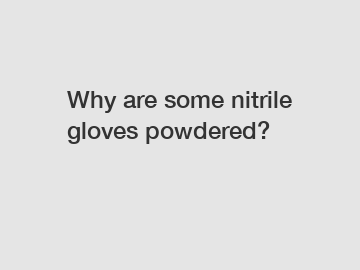Why are some nitrile gloves powdered?
Why Are Some Nitrile Gloves Powdered?
Nitrile gloves are widely used in various industries, including healthcare, food processing, and manufacturing, due to their superior protection against chemicals and pathogens. However, you may have come across the term "powdered nitrile gloves" and wondered why they exist. In this article, we will delve into the reasons behind the use of powdered nitrile gloves and whether they are still relevant in today's world.
1. Understanding the Purpose of Powdered Nitrile Gloves.

Powdered nitrile gloves have been used for decades, and their main purpose is to ease the process of putting on and taking off the gloves. The powder, typically made from cornstarch or other harmless substances, helps reduce friction and allows the glove to glide on smoothly. This can be particularly useful in situations where a fast glove change is required, such as in busy medical settings.
2. Enhanced Moisture Absorption.
Another advantage of using powdered nitrile gloves is their ability to absorb moisture. When wearing gloves for extended periods, sweat can accumulate, leading to discomfort and potential skin irritations. The powder inside the gloves can absorb this moisture, keeping the hands drier and offering a more comfortable experience. This feature makes powdered nitrile gloves desirable in environments where extended glove usage is common.
3. Improved Tactile Sensitivity.
Contrary to popular belief, the powder inside powdered nitrile gloves does not compromise grip or tactile sensitivity. In fact, the powder helps to enhance the wearer's grip by minimizing the chances of the glove sticking to the skin or other surfaces. This can be crucial in delicate procedures where a secure grip is essential, such as handling small instruments or conducting intricate tasks.
4. Potential Allergic Reactions.
5. The Rise of Powder-Free Nitrile Gloves.
The growing awareness of the potential drawbacks of powdered nitrile gloves has led to an increase in the popularity of powder-free alternatives. Powder-free nitrile gloves eliminate the risk of allergic reactions caused by the powder, making them a safer choice for both users and patients. Additionally, the absence of powder minimizes the risk of contamination associated with airborne particles, making them suitable for sensitive environments like laboratories and cleanrooms.
6. Diverse Applications of Powder-Free Nitrile Gloves.
Powder-free nitrile gloves have become the go-to choice in a wide range of industries. Their popularity stems from the fact that they provide excellent protection against chemicals, pathogens, and biological hazards, without the added concerns associated with powdered gloves. From healthcare professionals and laboratory technicians to food handlers and automotive workers, powder-free nitrile gloves offer a reliable solution for various tasks.
In conclusion, while powdered nitrile gloves have long played a significant role in applications requiring quick glove changes and moisture absorption, their usage has declined due to potential allergic reactions and contamination risks. The emergence of powder-free nitrile gloves has addressed these concerns, providing a safer and more versatile alternative. Nonetheless, it is important to note that both types of gloves have their place in specific scenarios, and the choice ultimately depends on the user's requirements and sensitivity to allergens. So, why are some nitrile gloves powdered? While their use has diminished, powdered nitrile gloves can still serve a purpose in certain situations where quick donning and enhanced moisture absorption are crucial.
If you want to learn more, please visit our website disposable medical gowns for america, disposable medical gowns for america, disposable medical gowns for america.



Comments
0